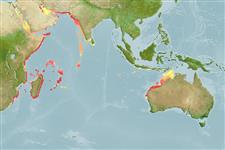>
Syngnathiformes (Pipefishes and seahorses) >
Syngnathidae (Pipefishes and seahorses) > Nerophinae
Etymology: Dunckerocampus: From Duncker, an ichthyologist and taxonomist that recognized four Gobiidae families (1928) + Gr, kampe = bent; boylei: Named for Bill Boyle, an underwater fish photographer who brought the species to the attention of the author.
Eponymy: Dr Paul Georg Egmont Duncker (1870–1953) was a German zoologist and ichthyologist. [...] Bill Boyle, an underwater fish photographer, brought this species to the author’s attention. (Ref. 128868), visit book page.
Environment: milieu / climate zone / depth range / distribution range
Ekologi
laut dasar (demersal); nir-ruaya; kisaran kedalaman 20 - 95 m (Ref. 31080). Deep-water
Indian Ocean: Red Sea, Mauritius and Tulamben, north coast of Bali, Indonesia. Expected to be wide ranging in the Indian Ocean and adjacent waters.
Size / Weight / umur
Maturity: Lm ? range ? - ? cm
Max length : 16.0 cm TL jantan/; (Ref. 48635)
deskripsi pendek
Kunci identifiaksi (pengenalan) | Morfologi | Morfometrik
duri punggung lunak (Keseluruhan (total)) : 21; Sirip dubur lunak: 4. Broader bands and diagnostic caudal fin pattern (Ref. 48635).
Adults prefer depths of about 25 m or more and is easily overlooked (Ref. 48635). Ovoviviparous (Ref. 205). The male carries the eggs in a brood pouch which is found under the tail (Ref. 205). Solitary or in pairs in caves and crevices (Ref 90102).
Male carries the eggs in a brood pouch (Ref. 205).
Kuiter, R.H., 1998. Pipefishes of the syngnathid genus Dunckerocampus (Sygnathiformes: Sygnathidae), with a description of a new species from the Indian Ocean. aqua, J. Ichthyol. Aquat. Biol. 3(2):81-84. (Ref. 31080)
Status IUCN Red List (Ref. 130435: Version 2024-2)
ancaman kepada manusia
Harmless
penggunaan manusia
Perikanan: tidak ada kepentingan
Alat, peralatan
laporan khas
muat turun XML
Sumber internet
Estimates based on models
Preferred temperature (Ref.
123201): 23.7 - 27.8, mean 26.1 °C (based on 42 cells).
Phylogenetic diversity index (Ref.
82804): PD
50 = 0.5078 [Uniqueness, from 0.5 = low to 2.0 = high].
Bayesian length-weight: a=0.00093 (0.00036 - 0.00242), b=3.05 (2.83 - 3.27), in cm total length, based on LWR estimates for this (Sub)family-body shape (Ref.
93245).
Trophic level (Ref.
69278): 3.7 ±0.6 se; based on size and trophs of closest relatives
Daya lenting (Ref.
120179): Tinggi, Waktu penggandaan populasi minimum kurang dari 15 bulan (Preliminary K or Fecundity.).
Fishing Vulnerability (Ref.
59153): Low vulnerability (10 of 100).
